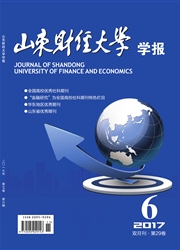

 中文摘要:
中文摘要:
长江经济带建设在中国区域发展格局中具有重要的战略地位,研究其经济发展的空间差异和溢出效应,对于全面建成小康社会、实现区域协调发展具有重要的现实意义。运用Dagum基尼系数、核密度分析以及广义脉冲响应函数方法,基于1992-2013年长江经济带110个城市的DMSP/OLS夜间灯光数据,对长江经济带区域发展差异及空间溢出效应进行了实证考察。研究发现:(1)样本考察期内,长江经济带区域发展总体上呈显著的非均衡发展态势;(2)区域间差异对总体差异的贡献始终大于区域内差异和超变密度的贡献,且贡献率不断上升,因此,上、中、下游区域间差异是造成长江经济带发展差异的主要原因;(3)VAR框架下的广义脉冲响应分析表明,长江经济带上游、中游和下游之间存在明显的空间溢出效应。
 英文摘要:
英文摘要:
The construction of the Yangtze River Economic Belt occupies an important strategic position in China regional development pattern, so it is of great practical significance for building a well-off society in an all-round way and realizing coordinated regional development to study its spatial differences and spillover effects. Based on the DMSP/OLS nighttime lighting data from 110 cities in the Yangtze River Economic Belt from 1992 to 2013 and by a- dopting Dagum Gini coefficient, Kernel density analysis and generalized impulse response function, this paper con- ducts an empirical investigation of the regional development differences and spatial spillover effects of the Yangtze River Economic Belt. The results show that during the sample inspection period, the Yangtze River Economic Zone presents a remarkably unbalanced development; the contribution of regional difference to the overall difference is al- ways greater than that of intra-regional variation and hyper change density with an increasing contribution rate, and the difference among the upper, middle and lower reaches is the main reason for the difference of the Yangtze River Economic Belt; and that the generalized impulse response analysis under the VAR framework indicates that obvious spatial spillover effects exist in the upper, middle and lower reaches of the Yangtze River Economic Belt.
 同期刊论文项目
同期刊论文项目
 同项目期刊论文
同项目期刊论文
 期刊信息
期刊信息
